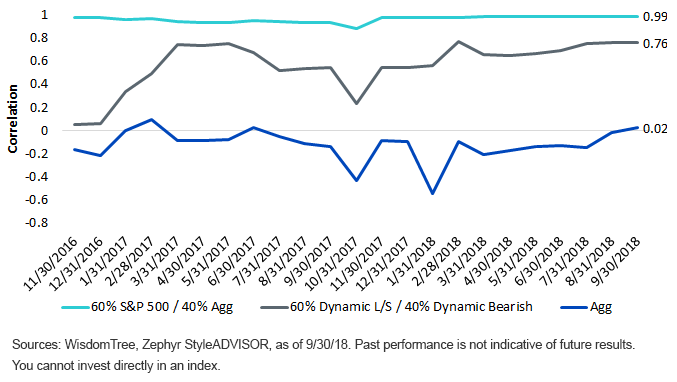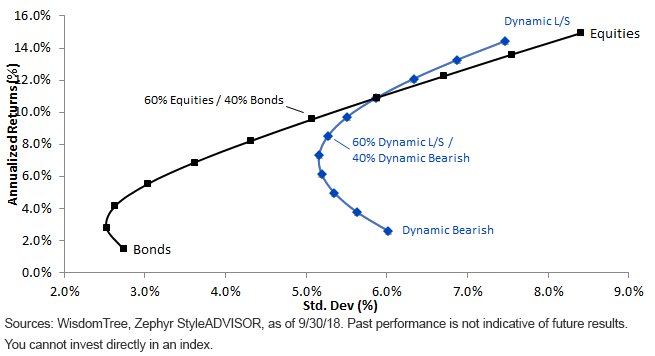How to Diversify a 60/40 Allocation with Dynamic Equities


If there is one thing to be learned from this year’s drawdowns in U.S. equities, it’s that traditional 60/40 portfolios1 do a comparatively poor job of limiting portfolio losses in the short run. In our view, this is primarily a function of low interest rates starting to rise. On the one hand, the amount of income a bond portfolio is able to generate is constrained, thus limiting expected total returns. On the other, rapidly rising rates have triggered a shift in equity risk premiums that result in lower prices for stocks and bonds. For that reason, investors have sought to increase exposure to alternative strategies that can generate returns in rising and falling equity/interest rate environments. Below, we highlight how investors can combine a dynamic long/short equity strategy2 with a dynamic bearish strategy3 to potentially achieve returns comparable to traditional portfolios but with significantly different drivers and correlations.
The Challenges of 60/40
As we’ve mentioned previously, the performance of 60/40 has been pretty tough to beat. With the benefit of hindsight, we know that the S&P 500 has generated returns of 11.97% per year over the last 10 years with abnormally low levels of volatility.4 However, what happens to investor portfolios when volatility increases and/or equities correct for more than a couple of months? In our view, investors have been lulled into a sense of complacency with 60/40. While they may feel like they’re diversified between stocks and bonds, the fact is that their portfolio remains dangerously exposed to equity market returns. In the chart below, we show that the current rolling 12-month correlation between 60/40 and the S&P 500 Index is at 0.99.
Rolling 12-Month Correlations to S&P 500 Index

While bonds show effectively zero correlation with stocks, our concern is that with the Fed continuing to normalize policy, the risk of negative returns from fixed income is elevated. In our view, a combination of alternative strategies can be used to reduce correlation with the S&P while generating returns that don’t rely on rising equity markets or falling bond yields.
Dynamic Long/Short and Bearish
Dynamic strategies seek to add value through security selection and by their ability to dynamically add and subtract exposure to equity market beta. When underlying fundamentals are strong, our dynamic long/short Index is long. When fundamentals become mixed, a partial hedge is applied. When fundamentals are weak, a full market hedge seeks to protect investors from downdrafts in the equity market while still delivering excess returns through security selection. In the case of our bearish strategy, when fundamentals are poor, all equity exposure is eliminated while those proceeds are invested in U.S. Treasury bills. This high-quality cash position combined with a short position in equity futures allows investors to potentially profit from a decrease in equity prices.
Below, we contrast combinations of these alternative strategies that can serve as a starting point for a liquid alternatives portfolio.
Dynamic Strategy Blends vs. Traditional Asset Blends
11/30/15–9/30/18

Contrasting 60/40s
While traditional 60/40 has outperformed our alternative 60/40 portfolio with slightly less volatility, we continue to like this combination given the potential to generate positive returns when equity markets fall or interest rates rise. Given that these portfolios rely on fundamentals to dynamically adjust their beta exposure to the market, they offer the potential to tap in to outperform during market corrections. Since the end of 2015, these dynamic strategies generally have been net long the market on account of strong fundamentals. However, they have also reduced exposure three separate times when valuations became extended and earnings growth momentum slowed. As a result, our alternative 60/40 portfolio has been able to capture much of the market’s upside while providing comparable volatility to a portfolio that includes fixed income assets.
Conclusion
In sum, while simply constructed portfolios have delivered above-average performance in recent years, it seems unlikely that the pace of such gains can be sustained. The later we continue into the economic cycle, the greater the chance we experience a sustained market correction. In our view, combining traditional assets with dynamic equity strategies could provide opportunities for returns despite a fall in equity prices. By combining long/short and bearish strategies together, investor exposures can be dynamically adjusted based on underlying market fundamentals.
1Sixty percent equity and 40% fixed income proxied by the S&P 500 Index and the Bloomberg Barclays U.S. Aggregate Index.
2Proxied by the WisdomTree Dynamic Long/Short U.S. Equity Index.
3Proxied by the WisdomTree Dynamic Bearish U.S. Equity Index.
4Source: Bloomberg, as of 9/30/18.


